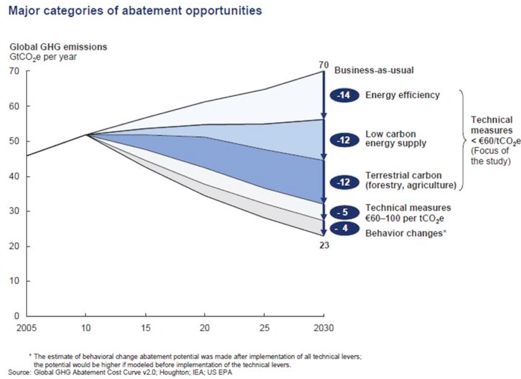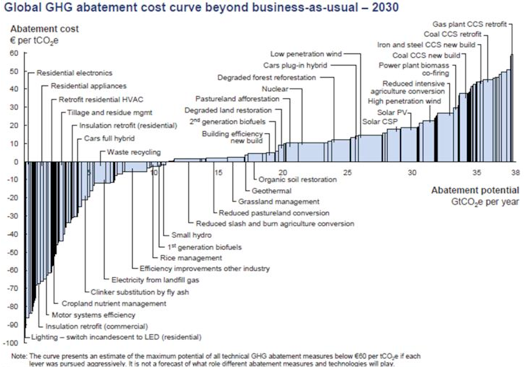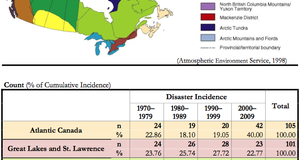From Earth Common Journal VOL. 3 NO. 1Climate Change Strategies 101Government: The Policy Development PhaseThe entire climate change policy process is often organized into four phases: political agenda setting, policy development, implementation, and review/monitoring (Figure 1, Macdonald, 2011). The policy development phase, wherein the climate strategy or plan is forged, usually has at least five generic steps:
Background policy and scientific work This step involves a number of tasks that must be undertaken in order to develop a robust and defensible strategy. These steps include the following: 1. Developing an accurate GHG inventory of historical and future emissions for the area. From this, knowing which sectors of the economy have the highest GHG emissions and their importance to the overall economy become critical. Historical emissions are usually easier to determine than future forecasts. In both cases, some simple assumptions need to be made and documented in the final plan. Future forecasts of GHG emissions can have a high degree of uncertainty to them. Figure 2. Policy options as wedges and resulting GHG targets (McKinsey, 2009)
2. Developing a clear understanding of what the scientific community is recommending regarding global GHG reductions and what the international community might find a “credible” target and level of effort. 3. Brainstorming and economic analysis on possible mitigation policy options and the development of cost curves to rank options from best (economic return) to worst (economic loss) and how these options might add up to GHG reduction targets (Figure 2). 4. Undertaking a preliminary assessment of a country’s vulnerabilities to climate impacts and quantifying this in a financial and risk management context. Consultation process Most governments in Canada undertake some kind of climate change consultation process to achieve a number of strategic objectives, including the following:
Having said this, jurisdictions have engaged in a full spectrum of consultation processes - all the way from plans that are developed internally by government, to “back room” discussions with key industry players to public consultation processes that are full and transparent. In Canada, the federal government is obliged to consult, to some extent, with provinces and territories on climate policy. This relates to jurisdictional ownership of fossil fuel resources, which is a provincial responsibility. Tradeoffs with the final consultation approach usually hinge on time to reach agreement (longer with transparent processes, shorter with internal) versus final buy-in and support for the plan (more for transparent processes, less for internal processes). Some countries, like the U.S., leave consultation to lawmakers and employ lobbyist groups to represent their stakeholder views. Historically, Canada has had lengthy stakeholder consultation processes on climate change plans. At least four approaches have been taken, listed here from least to most participatory:
Again, the final selection of which consultation process to choose is often a matter of trade-offs and political commitment. Limited consultations tend to be more expeditious, but tend to alienate stakeholders leading to poor public and industry support for the final climate plan. Broader consultation approaches tend to take a very long time, but may have wide support once agreement is reached. However, participatory consultation may make it difficult to reach agreement given the multiple points of view that are usually brought forward. Governments can also use extensive consultations on climate policy to stall for time and avoid taking action. Economic/policy analysis and target setting This stage is where the real detailed work gets done. It often begins with a policy analysis to define a “basket” of approaches that might work in a particular jurisdiction. Cost curves are determined at this point. Cost curves set out a range of reduction options, how many tonnes they will deliver and for what carbon price. Policy options are then put in an economic model to determine what kind of reductions can be achieved, the impact to the economy, and in what timeframe. Alternatively, some economic models allow the user to set a price for carbon (e.g. $10/tonne, $50/tonne, $100/tonne, etc.) and the model produces a suite of policy options that are achievable at these various carbon price signals (Figure 3). A simplified first approximation can be derived by taking the jurisdiction’s annual GHG emission, deciding on a percent reduction target and then reading off the cost curve what this reduction is likely to cost. Cost curves also suggest which policy options to proceed with first (most economic at the far left) to last (i.e. most expensive - far right of the graph). Figure 3. Global GHG abatement cost curve beyond business as usual – 2030 (McKinsey, 2009)
Building political support for a target and policy package Once the analysis stage is complete, a discussion with political decision makers can begin. At this point, all of the key strategic questions discussed earlier need to be carefully considered. In particular, the question of depth of targets versus economic cost versus political salability need to be finalized. GHG reduction targets continue to be the political and scientific focus of climate plans/strategies. International credibility and reputation also comes to bear at this stage – too light of a target will fail to gain international credibility, while too aggressive a target is unlikely to be approved domestically - due to anticipated high costs. Questions invariably arise as to whether the intent is to be a leader, a laggard/minimalist, or to fall in line with what other countries are proposing or actually doing. This is not unlike the Goldilocks and the three bears story – not too hot – not too cold – somewhere in the middle is often just right – often regardless of what the science is saying! Once a draft target and its associated policy measures are agreed upon in the lead Ministry/Department, it is this Minister’s/ Secretary’s job to convince cabinet colleagues and the Opposition that this is the way to proceed. Refinement and final political approval The initial climate change plan/strategy with its targets and policies is invariably not the final version that is released to the public. Once politicians begin to “shop the plan around” to colleagues, a myriad of concerns arise that must be addressed. Compromises, additions, deletions and changes are invariably made to the plan. Unfortunately, in Canada at least, the draft climate plan often drifts away from something that represents sound policy, scientific, and economic analysis to something that is politically acceptable. The final product may bear little semblance to the original draft developed internally or through consultations. However, politicians with a strong understanding of the economics and analysis that went into the initial draft plan can be very effective in minimizing this “drift.” If a politician has done their job well with behind the scenes discussions with cabinet colleagues, when the final plan comes to cabinet for approval, it passes relatively easily. In some jurisdictions a legislative body must approve the climate plan and this in turn can add months or years to the approval process and generate a multitude of policy changes. Because climate change is a global issue, and so political, the national/provincial/ state leader (President, Prime Minister, Governor, Premier) often takes the lead in releasing the plan and attending to follow-up media interactions. The release of climate plans is often done at major national or international climate change events to maximize their exposure. This is often followed up by a series of announcements that progressively release any details that are available. This release process also builds public interest and support for the plan. For a serious climate change policy initiative, the strategy/plan usually then moves back to the administrative side of government for implementation.Continued on Next Page » Suggested Reading from Inquiries Journal
Inquiries Journal provides undergraduate and graduate students around the world a platform for the wide dissemination of academic work over a range of core disciplines. Representing the work of students from hundreds of institutions around the globe, Inquiries Journal's large database of academic articles is completely free. Learn more | Blog | Submit Latest in Environmental Studies |



















